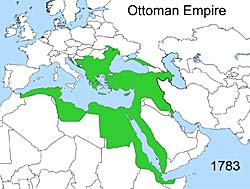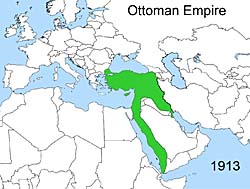
Unit 4: Nationalism, Industrialism, and Imperialism
Lesson I: The Dual Forces of Nationalism
Activity 4: Nationalism Brings Conflict to the Ottomans
The Ottoman Empire had been growing constantly since the early 1300s. As nationalism spread, however, the empire was greatly impacted. Analyze the following maps to prepare for a class discussion.

[1]

[2]
Classroom Activity - Ottoman Empire Map Analysis
![]() Discussion
Discussion
Directions: Prepare a response to the discussion questions below. Follow your teacher's directions to participate in your class discussion.
- What territories had the Ottomans lost by 1913?
- Predict reasons why nationalism acted as a divisive or a unifying force in the Ottoman Empire.
Select the link to review the Discussion Scoring Tool (pdf).
While in Germany and Italy nationalism acted as a unifying force, in the Ottoman Empire the opposite is true. As nationalism continued to spread and grow in Ottoman territory, the empire's power declined and the Ottomans faced increasing problems.
In Unit 2, you learned how the Ottomans unified diverse regions through methods such as religious tolerance. Now, read information on how nationalism was a source of tension and conflict in places such as the Ottoman Empire. Be prepared to answer questions about the Ottoman Empire at the end of the reading.
At its height, the Ottoman Empire spanned over three continents. The Ottomans had vast land holdings in the Middle East, North Africa, and Southeast Europe. By the early 1800s, however, the empire faced serious challenges.
Problems for the Ottoman Empire
The Ottoman Empire weakened due to economic struggles and political corruption. During the 1700s, the central government lost much of its power. In several parts of the empire, local leaders and military commanders tried to take advantage of the government's weakness. Internal revolts became more commonplace as people responded to feelings of nationalism - nationalism not related to the Ottoman Empire. Why did nationalism drive people to revolt instead of to feel loyal to the Ottomans?
Turkish Muslims dominated the Ottoman government. The empire, due to its vast holdings, included many languages, religions, and ethnicities. Many subject peoples in North Africa, Eastern Europe, and the Middle East did not identify with the dominant Ottomans as they did not share a strong common culture. They felt they should be independent of the Ottomans and have their own countries.
The Ottomans did the best they could to suppress uprisings in Arabia, Lebanon, Armenia, and other parts of their empire using their military. However, in Eastern Europe, the Greeks, Serbs, Bulgarians, and Romanians all revolted and gained their independence. The Ottomans also lost control of Egypt and Libya in Africa. The further loss of territory added to their economic troubles.
Moreover, European countries like Austria, Russia, and France tried to take advantage of the Ottoman's decline by seizing Ottoman territory. European ambitions increased the pressure on the Ottomans to reform their empire and to stop their downfall.
Efforts to Reform
Ottoman rulers looked to the West for ideas to strengthen their empire. Using the European model, they reorganized their bureaucracy and system of tax collection, built railroads, improved education, and hired Europeans to train their military. The Ottomans even encouraged young men to attend school in Europe to study science and technology.
However, nationalistic Ottoman officials were uneasy with so much change from a foreign culture. This led to a series of repressive leaders who rejected reform and tried to rebuild the more traditional, oppressive power enjoyed by earlier rulers.
In the 1890s, a group of well-educated nationalists formed the Young Turks. They insisted that reforms were the only way to save the empire and tried to push a constitution on the sultan. When this attempt failed, the group overthrew the sultan in 1908. They emphasized national pride in the Ottoman Empire and European-inspired reforms. Before they could fulfill their hopes for reform, however, everything was put on hold as Europe moved into World War I.
Directions: Answer the following questions to check your understanding of nationalism in the Ottoman Empire.
Page Notes:
[1] Source: This image from http://commons.wikimedia.org/wiki/File:Territorial_changes_of_the_Ottoman_Empire_1783.jpg is in the public domain.
[2] Source: This image from http://commons.wikimedia.org/wiki/File:Territorial_changes_of_the_Ottoman_Empire_1913b.jpg is in the public domain.

